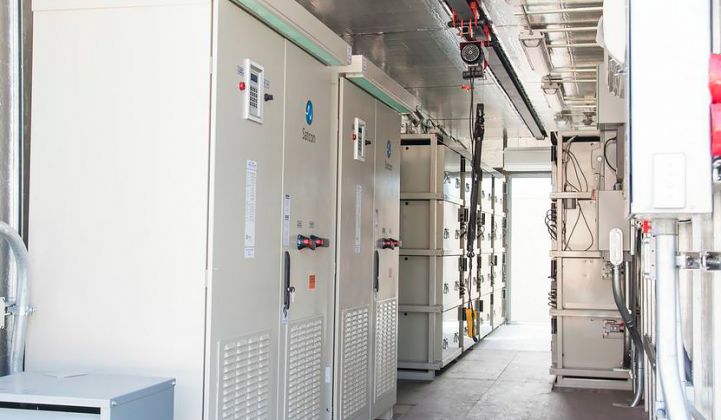In August, we reported that privately held Greensmith, a provider of software for grid-scale energy storage, had closed an "oversubscribed" $12.3 million C round of funding with help from venture investors and $5 million from utility behemoth AEP.
Despite its "oversubscribed" condition, Greensmith has allowed itself to collect an additional $5 million from another impressive name in energy, European utility giant E.ON. That brings Greensmith's investment total to about $27 million. Greensmith has also won funding from VC firms Cota Capital and Maryland's own TDF Ventures.
The energy storage market has received more than $270 million in venture capital funding this year, according to GTM Research. Key Greensmith competitor Younicos just raised $50 million in a funding round that included First Solar -- bringing its funding total to about $250 million.
Greensmith CEO John Jung told GTM this morning, "We are scratching our head about the amount of money being raised out there." Although Greensmith is a software vendor (and that's why the scale of funding is not out of control), it has been pulled by the market to deliver turnkey energy storage hardware solutions as well. (Sunverge has followed this same path in residential energy storage.)
Jung said that Greensmith wants to raise "the least amount of money possible," adding that AEP and E.ON were good choices amongst many strategics because they understand this business and "have learned the hard way that not all [energy storage] suppliers are created equally." He noted that AEP was one of the first to deploy NGK's sodium-sulfur batteries at the substation. Jung also noted that E.ON had "looked at all the major providers, including a major provider out of Europe." He added that the E.ON connection will help Greensmith reconfigure its product for Europe.
E.ON's Susana Quintana-Plaza, senior VP of technology and innovation, admitted, "The energy industry is undergoing a fundamental transformation" -- and that's a strong impetus for E.ON's investment in Greensmith and other energy companies such as Sungevity, Enervee, AutoGrid and Thermondo.
Greensmith projects range from a 20-megawatt system providing frequency regulation for grid operator PJM to 30-kilowatt behind-the-meter batteries in California, along with newer projects balancing intermittent solar power in Hawaii and Puerto Rico. Duke Energy is working with Greensmith on a 2-megawatt storage project featuring lithium-ion batteries from LG Chem.
Greensmith has incorporated a 14 different types of batteries, including multiple lithium-ion chemistries, as well as Aquion Energy's sodium-ion battery and ViZn Energy’s zinc redox flow batteries, into its software suite.
About two-thirds of the company's customers are electric utilities, including San Diego Gas & Electric and Sacramento Municipal Utility District, according to the CEO, who said he wants as many stakeholders as possible "to take advantage of the software stack."
Jung said, "2015 is about viability and ROI delivered." He added, "At our core, we are a software developer with design and integration capability." Jung emphasized the benefit of building, interconnecting, and commissioning turnkey systems: "If you don't understand the technology involved or understand the grid interconnection -- then you don't really understand how to build storage-system software."
Greensmith is providing its software for about 45 projects with 25 different customers, and has nearly 500 megawatts of projects in a pipeline that “is growing on a weekly basis,” Jung noted that one of the growth pieces of the pipeline were "non-RFO captive" applications with strong ROIs.
The company has also done several behind-the-meter projects, including two 1-megawatt battery systems, one in Puerto Rico and another in Ohio, according to Jung. These are much bigger projects than the typical behind-the-meter battery systems being installed in buildings by companies like Stem, Sunverge, Green Charge Networks and Coda Energy or Tesla and SolarCity.
The projects are not just aimed at providing demand-charge reduction for customers’ utility bills, a revenue stream with an "anemic ROI," according to the CEO. Instead, “some of these customer-sited systems are participating in frequency regulation,” he said, while the Puerto Rico project is specifically aimed at meeting the smoothing and ramp-control requirements for new solar and wind projects being built on the island.
GTM Research predicts the U.S. will deploy 192 megawatts of energy storage in 2015, with the market on a path to surpass 1 gigawatt of annual installations and a value of $2 billion in 2020. GTM Research grid analyst Andrew Mulherkar notes that "E.ON joins AEP, RWE, ČEZ, Constellation, Iberdrola and EDF as holding companies with distribution utility subsidiaries that have invested in software-centric energy storage vendors. Such vendors (including Younicos, Greensmith, Advanced Microgrid Solutions, and Stem) have received nearly $145 million in VC this year."
Brett Simon, GTM Research energy storage analyst, notes, "Greensmith is active outside the U.S. Having an established foothold for its products in Australia will help Greensmith reap the benefits of the burgeoning Australian energy storage market across the non-residential and utility segments."
Greensmith's CEO said that the difference between solar or wind and energy storage is that "you can't unleash its potential unless you have the software right. And we have the best software in the business."
***
Jeff St. John contributed to this article



